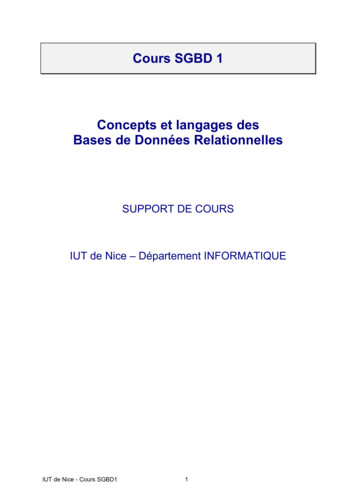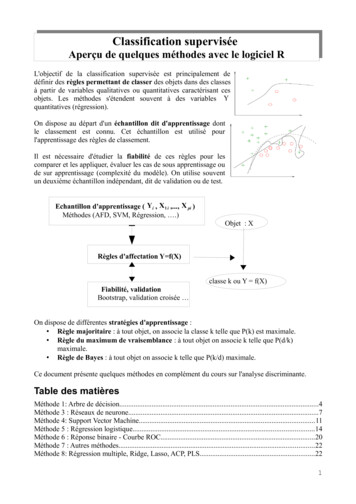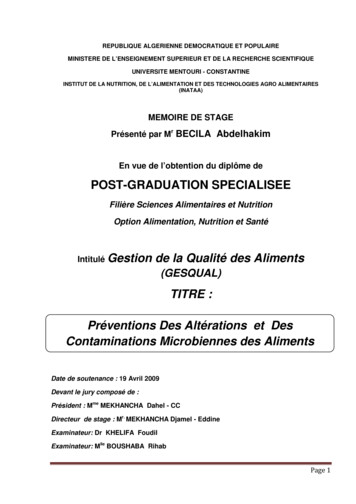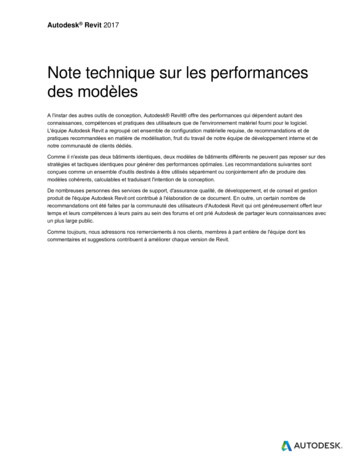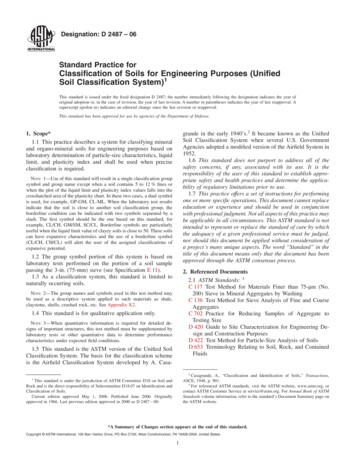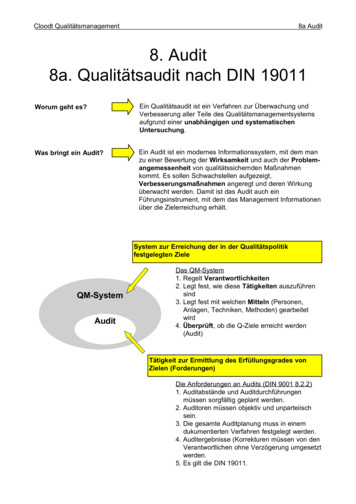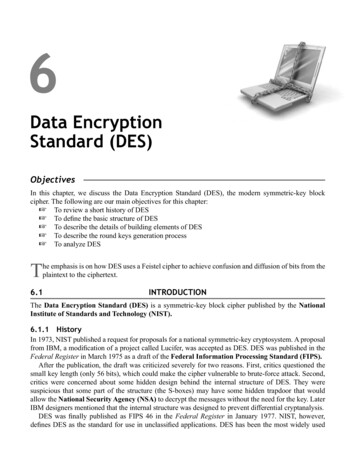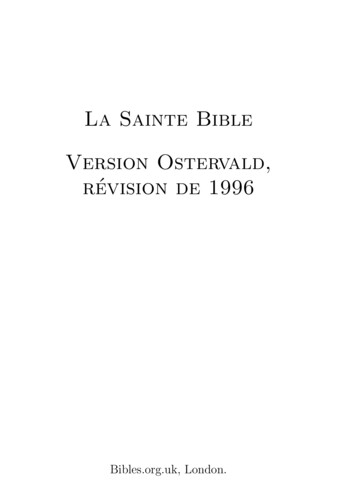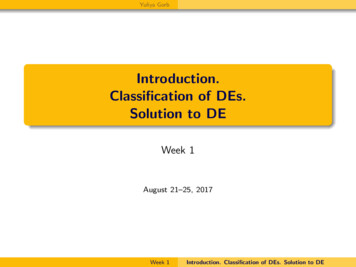
Transcription
Yuliya GorbIntroduction.Classification of DEs.Solution to DEWeek 1August 21–25, 2017Week 1Introduction. Classification of DEs. Solution to DE
Yuliya GorbMATH 3331: Ordinary Differential EquationsSyllabusCan be downloaded at course webpage1Course Info:Meet T/Th 11:30am–1:00pm in SEC 2062Contact Info: Dr. Yuliya GorbOffice: PGH 671Email: gorb@math.uh.eduOffice telephone: (713) 743-4130Mailbox: in PGH 651Office Hours: T/Th 10:00am-11:00am, and/or by appointment34Textbook: J. Polking, A. Boggess and D. Arnold “DifferentialEquations”, 2nd ed, Wellesley – Prentice Hall, 2006Assessment:HW40%Every weekMidterm I30%October 5, 2017Week 1Midterm II30%November 28, 2017Introduction. Classification of DEs. Solution to DE
Yuliya GorbMATH 3331: Ordinary Differential EquationsSyllabus (cont.)5HOMEWORKUsually assigned every week and are due on Tuesday of thenext week in the lectureDo all the assigned homework problems, however only a fewrandomly selected problems will be gradedLate homework will not be acceptedCollaboration on homework is allowed, but you have to writeyour entire solution by yourselfAll work must be shownDo not forget to put your name and ID # on it, homeworknumber and staple all the sheetsAll homework assignments are mandatory, although, only 10the best scores would count in the final grade6EXAMS:Class midtermsThere is no final examNo collaboration on exams is allowedNo books, cell phones, calculators or notes of any sortWeek 1Introduction. Classification of DEs. Solution to DE
Yuliya GorbMATH 3331: Ordinary Differential EquationsODEs: IntroductionDefinitionAn equation that contains a derivative of an unknown functions iscalled differential equation (DE)DefinitionOrdinary differential equation (ODE) contains an ordinaryderivativeMany of the principles, or laws, underlying the behavior of thenatural world are statements or relations involving rates at whichthings happen. When expressed in mathematical terms therelations are equations and the rates are derivativesDefinitionA differential equation that describes some physical process isoften called a mathematical model of the processWeek 1Introduction. Classification of DEs. Solution to DE
Yuliya GorbMATH 3331: Ordinary Differential EquationsClassification of DEsBased on the number of independent variables the unknown functiondepends on: ODE vs PDE (Partial differential equation)Examples:1t 2 y ′ 5(sin t)y 2 2u 2u 2 f (x, y ) x 2 xODE for y y (t)PDE for u u(x, y )2 Based on the order of the highest derivative of unknown fn: Order of DEDefinitionThe order of a DE is the order of the highest derivative of unknown functionGenerally, the equationF [t, y (t), y ′ (t), . . . , y (n) (t)] 0(1)is an ordinary differential equation of the nth order.Examples:u ′′′ 3u cos x3rd order ODE for u u(x)d 2y2nd order ODE for y y (x) 0dx 2Week 1Introduction. Classification of DEs. Solution to DE
Yuliya GorbMATH 3331: Ordinary Differential EquationsClassification of DEs (cont.)3Linear vs Nonlinear DEDefinitionAn ODE is linear is the function F in (1) is linear,that is, the general linear ODE of order n isan (t)y (n) an 1 (t)y (n 1) . . . a1 (t)y ′ a0 (t)y g (t)(2)Most of the equations that we discuss in this course are linearDefinitionAn ODE that is not of the form (2) is a nonlinear equationExamples:1linear ODE1 x2nonlinear ODE (because of the term 2uu ′ )x 3 y ′′′ 2(cos x)y ′ u ′′ 2uu ′ 0(y ′ )2 3t 2 y ′ 5y 0nonlinear ODE (because of (y ′ )2 )Week 1Introduction. Classification of DEs. Solution to DE
Yuliya GorbMATH 3331: Ordinary Differential EquationsClassification of DEs (cont.)4Based on the number of unknown functions:Single Equation vs System of DEsExamples:x 3 y ′′′ 2(cos x)y ′ 11 x2 system of ODEs for u u(t) and v v (t)u ′ 2vv′ u t 0Week 1single ODE for y y (x)Introduction. Classification of DEs. Solution to DE
Yuliya GorbMATH 3331: Ordinary Differential EquationsSolution to DEDefinitionA solution of a DE is a differentiable function that gives a trivial identity afterbeing substituted back to the equationExamples:Verify that y (t) 3t t 2 is the solution of ty ′ y t 2 ?Evaluate: y ′ (t) 3 2t and substitute back to the equation:t(3 2t) 3t 2 t 2 LHS † , whereas RHS t 2 † LHS RHS†LHS “Left hand side”, and RHS “Right hand side”A family of solutions to a given ODE is called general solution that containsconstant(s) coming from integrationTo obtain a representative of this family of solutions, one needs to prescribe aninitial condition. For ex., for the 1st order ODE we haveInitial Value Problem (IVP): ′y (t) f (t, y ), where t0 and y0 are given numbersy (t0 ) y0Week 1Introduction. Classification of DEs. Solution to DE
Yuliya GorbMATH 3331: Ordinary Differential EquationsFalling Object ExampleSet up and solve a mathematical model for an object that is falling in theatmosphere near sea level from the resttvmgγaFtime, [s] (independent variable)velocity, v v (t), [m/s] (dependent variable)mass, [kg ]acceleration due to gravity, g 9.8 [m/s 2 ]drag coefficient, [kg /s]acceleration, [m/s 2 ]net force, [N kg m/s 2 ]Newton’s 2nd Law:F m aNote, that both F and a are vectors so we need into account theirdirections. The net force F consists of the gravity f grav and airresistance force (drag) f drag so that F f grav f drag , where f grav m g , g (0, g )T . The drag force is somewhat difficult to model but weassume that it is proportional to the velocity v , i.e. fdrag γv (t).d vLastly, recall that the acceleration is a .dtIntroduction.Classification of DEs. Solution to DEHence, the equation of motion ofWeekthe1 objectbecomes:
Yuliya GorbMATH 3331: Ordinary Differential EquationsFalling Object Example (cont.)Hence, the equation of motion of the object becomes:dv mg γvmdtTo conclude setting up the model we have to supply the above ODE with aninitial condition (IC), which is v (0) 0, as the object started its motion fromrest. Therefore,Mathematical Model: m dv mg γv(3)dt v (0) 0Now assume, that m 10 kg and γ 2 kg /s, then the ODE in (3) becomesdvv 9.8 ,dt5that we will solve. For that, rewriteWeek 1v 49dv dt5 dv /dt1 v 495Introduction. Classification of DEs. Solution to DE
Yuliya GorbMATH 3331: Ordinary Differential EquationsFalling Object Example (cont.)We now observe, thatddv /dt (log v 49 ) ,v 49dtthend1(log v 49 ) .dt5Now integrate:1log v 49 t C , that we solve and obtain:5v (t) 49 Ce t/5 ,where C is an arbitrary const(4)The function v in (4) is the general solution, and we have to find a particularsolution satisfying the given IC C 49:v (t) 49 49e t/5 [m/s],(5)that gives dependence of the object’s velocity on any moment of time t.Week 1Introduction. Classification of DEs. Solution to DE
Yuliya Gorb MATH 3331: Ordinary Differential Equations Syllabus Can be downloaded at course webpage 1 Course Info: Meet T/Th 11:30am-1:00pm in SEC 206 2 Contact Info: Dr. Yuliya Gorb Office: PGH 671 Email: gorb@math.uh.edu Office telephone: (713) 743-4130 Mailbox: in PGH 651 Office Hours: T/Th 10:00am-11:00am, and/or by appointment

